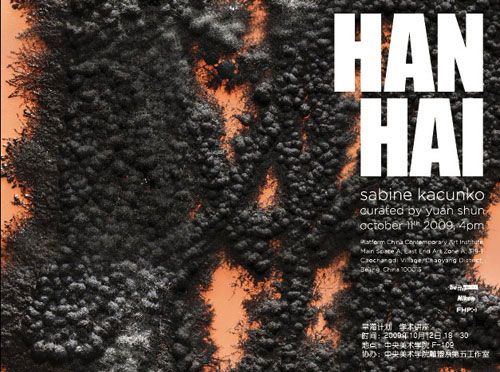
Platform China Contemporary Art Institute is pleased to hold Sabine Kacunko interactive media performance -Dry Sea. Artist Sabine Kacunko took the poetic Chinese name for Ghobi desert "han-hai"("Dry Sea") as title for her new work which she specially developed for Platform China in Beijing. In her multilayer spatial installation the artist touches central sociopolitial and environmental questions and leads directly into existential considerations about the relationship between humans and nature which today is characterized by an increasing tension.
For "Dry Sea" Sabine Kacunko, in cooperation with international scientists, created image files of experimental desert varnish production attempts using a microscope. These image files are the source material for the interactive spatial installation "Dry Sea" The microcosm of desert varnish is rear-projected on a screen whose proportions in the exhibition space remind of a wall. In the beginning of the performance of "Dry Sea" the greyish desert varnish is visible as "all-over"on the screen. A camera records all visitors as long as they move behind the projection wall. This information is forwarded to a computer on which the images of the desert varnish are saved. The image files are controlled by a software which was specially developed for this installation. The more people enter the room, the more fragemented the image on the screen gets, the patina regresses, until it, resp. its image, has completely disappeared. The references and thought-provoking impulses the work provides reflect the sensitive ecological and economic balance which holds the world we live in and which is to maintain resp. to rebuild. With her visually impressive interactive installation "Dry Sea" Sabine Kacunko does not only visualize the mystic beauty of natural processes but also the efficacy of human actions.
Sabine Kacunko (born in Kassel, Germany, lives and works in Berlin) has been focussing on the complex relationship between human and nature for a long time now. Her photographs of plants, minerals and animals are created exclusively with natural light and in black-white. Seemingly familiar things unfold an unexpected power and provide space for numerous associations which are subtly guided by the artist's attempt to fathom the world and our relation to it. Since 2005, Sabine Kacunko has been pursuiting the multimedia-based global project BOOTSCHAFT in public spaces. By using complex artistic set-ups BOOTSCHAFT draws attention to objects with a special cultural and ecological background and thus to essential sociopolitical and environmental contexts. For more information please see www.sabinekacunko.de.
Desert varnish is a product of rock weathering or biopitting and functions like a multilayered finely interwoven carpet of microscopic scale. The protective pigments of desert organisms absorb solar radiation in a different way from pure rock and thus help to equilibrate the albedo and hereby stabilise climatic conditions. If it were possible to artificially initiate the biofilm growth of desert varnish one could possibly counteract desertification to some extent.
The project is supported by the mayor of Berlin, chancellery of the Berlin senate, cultural affairs. Freie Universitat, Berlin, Charit?Berlin. Nikon Germany, Panasonic Germany.